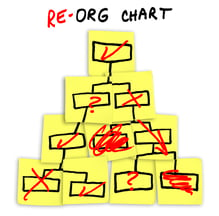Organizational Structure and the Growth of Your Financial Institution


Don't Miss An Episode, Subscribe Now
Financial Institution Organizational Structure: Challenges Abound Within the Financial Services Industry
In order for companies to grow successfully it's essential for leaders to be intentional and strategic when it comes to hiring. But as credit unions and community banks grow, staffing often must expand along with total assets, and this growth can sometimes lead to a counter-intuitive segregation of duties.
HR growing pains are not a problem that are specific to only financial institutions, but rather this is a challenge that is faced as many types of businesses expand. Many company leaders tend to find themselves trying to design the growth of a business around their existing staff, melding positions with people who are already in place. Unfortunately, this can become a real problem.
We’ve seen many medium to large financial institutions place digital responsibilities on mobile banking staff, programmers, or other IT personnel. Thus, keeping this area of control outside of marketing or communications departments. We’ve seen FIs with too many staff in the mix, all in various departments. This decentralization can cause the lack of a clear chain of command, and thus teams fail to adequately follow up on what is or is NOT being accomplished.
 Unfortunately, there’s no template for how a community bank or credit union SHOULD be organized. But with a greater number and specialization of staff comes the potential for inefficiency and decentralization of responsibilities.
Unfortunately, there’s no template for how a community bank or credit union SHOULD be organized. But with a greater number and specialization of staff comes the potential for inefficiency and decentralization of responsibilities.
Both of these can lead to larger marketing and sales campaigns that are disjointed, missing specific goals, and lacking a clear plan for implementation or measurement of results.
Community-Based Financial Institutions also often grow based on the skill sets of existing employees. They tend to promote from within, which is a great strategy for building a positive work culture, but this can lead to challenges in other areas.
Smaller banks and CUs often don't hire from outside the institution unless someone leaves the organization. This practice can sometimes leave an institution with gaps in technical expertise in areas of innovation or change.
LEARN MORE: 12 Decisive Steps to Grow Your Financial Institution
It is essential that financial institutions periodically restructure staff based on skill sets, assessing areas of need and then filling those gaps, rather than simply letting departments expand and change over time via staff attrition and organic growth.
Keeping departments organized as they have always been, for the sake of preserving the status quo, is a dangerous habit, though one that is all too common.
Be wary… when evaluating FI organizational structure, the ‘path of least resistance’ may lead to inertia and stagnation.
We recommend that financial Institutions keep all forms of member communications and marketing within ONE department’s chain of command.
However, it is also essential that marketing goals and objectives are tied and coordinated directly with frontline sales and lending staff so that digital sales leads from one department are then properly followed up on through the other and in a timely manner.
Credit unions and community banks should also have some form of Service Level Agreement (SLA) between marketing and sales so that individual team members understand their roles and expectations about the buyer's journey.
If, for example, marketing is driving leads in the form of emails or phone numbers for potential new loans, and then member service or your lending team is failing to adequately follow up with these leads, you will likely see staff frustration and a general lack of success. The reverse can also be said, if marketing is driving the wrong types of leads - the lending department can often become frustrated. It's important that lending and marketing work closely together.
Some financial institutions group Marketing and Business Development staff into one department to better connect leads to follow-ups and conversions. This is potentially a very good practice, but depending on the size of the FI this may or may not be practical.
Remember that it's easy to tell people they should be doing some kind of specific sales or marketing activity, but if these staff members don't have the time in their day or the best practice training to implement a new idea or approach, they will likely fail. Again this will only lead to staff frustration and a general lack of growth.
We also recommend a Customer Relationship Management Tool (CRM) be in place and utilized by BOTH Marketing and Sales/Business Development so that relationships with new member/customer leads can be better nurtured over time.
Read more about how to GROW your Credit Union or Community Bank in our recent e-book! Or contact us and we can tell you all about it in person! Thanks for Reading... Happy Growing!





Blog comments